Namibia 2021 Photo Expedition, April 4 ~ 20, 2021
FirstLight is offering a Namibia Photo Expedition, April 4-April 20, 2021 !!
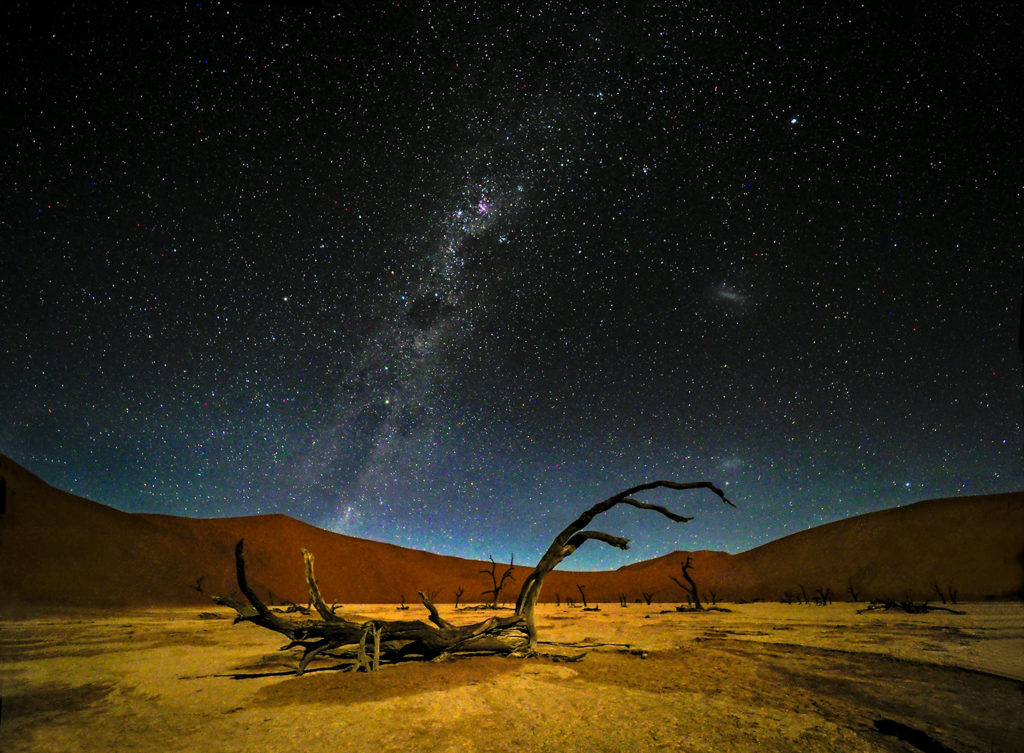
E-M1 MkII. M. Zuiko 7-14mm f2.8
Celebrated for its spectacularly vast open landscapes, this immensity of space is accentuated by the sparseness of population. Namibia is the 5th largest country in Africa, but hosts one of the lowest population densities. The lunar-like landscape produces one of the driest places on earth, but life is still there: from the Himba, one of the last true nomadic tribes on earth to the Bushmen of the northeast, to the desert-adapted elephant and one of the largest herd of wild black rhino, the diversity of this magical land is the answer to that question of “Why Namibia?”
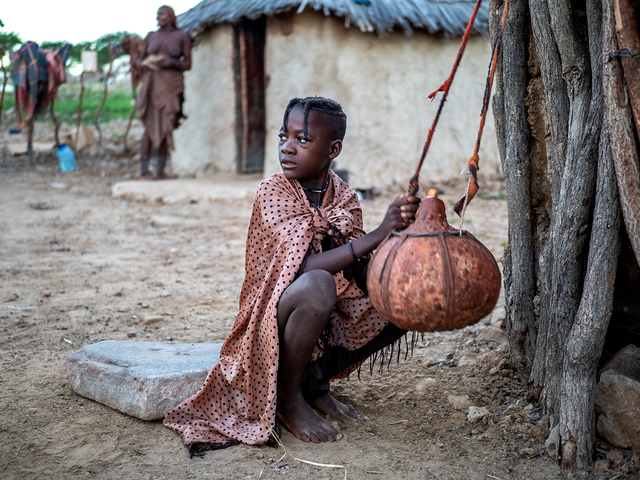
E-M1 MkII M.Zuiko 25mm F1.2
The western part of the country along the Atlantic Coast, essentially the Namib Desert, consists of a mixture of enormous red sand dunes, open gravel plains, rugged valleys and fringing mountainous escarpments. The desolate northern coastline, strewn with shipwrecks, seal colonies, and whalebones is known as the Skeleton Coast and is one of the world’s iconic locations. The red dunes of the central Namib further inland create the phenomenon known as Sossusvlei – a parched former oasis dwarfed by the world’s tallest sand dunes set against the azure sky. And Damaraland, where conservation efforts are making huge inroads into saving the vast tracts of wilderness shared by traditional communities and rapidly growing numbers of wildlife.
Why Namibia?—because it’s one of the last places on earth to see that interaction of wilderness, wildlife and mankind. I first had the opportunity to photograph in Namibia in 2006, and promptly fell in love with the amazing photographic opportunities offered in this incredible county. Though not the wildlife density of other African locations, this is easily balanced to the positive with the incredible availability of cultural photographic possibilities as well as the landscapes found nowhere else on this planet.
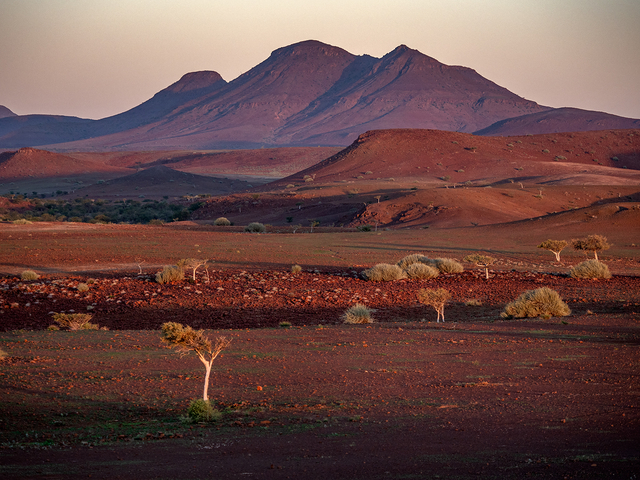
E-M1 MkII M.Zuiko 40-150mm f2.8 Pro Lens
The photo expedition will be a seventeen-day event (from your arrival until departure) along with a handful of participants, covering all the places that I’ve found so incredible in Namibia. No other workshop is offering a tour covering the broad reaches (photographically and otherwise) of that region.
I’m working with the same outfitters, Ultimate Safaris, that I used on our FirstLight 2016 & 2018 Namibia Photo Tours as well as my first trip there in 2006. This is the same one NG uses for their Expeditions in Namibia because they are simply the best.
ITINERARY IN BRIEF
Day 1 Arrive in Victoria Falls, Victoria Falls Hotel
Day 2, 3 & 4 Road transfer to Pangolin Voyager Houseboat, Chobe & Zambezi Rivers
Day 5 & 6 Road transfer to Kasane Airport, Fly to Nhoma Safari Camp, Bushmanland
Day 7 & 8 Fly to Palmwag, road transfer to Grootberg Lodge, Grootberg Plateau
Day 9 & 10 Road transfer to Desert Rhino Camp, Palmwag Concession
Day 11, 12 & 13 Fly to Sossus Dune Lodge, Namib Naukluft National Park
Day 14 & 15 Drive to Lüderitz Nest Hotel, Lüderitz
Day 16 Fly to Windhoek, Hilton Hotel
Day 17 Departure from Windhoek International Airport
Ultimate Safaris & FirstLight have put together a tour that includes all the “best-of” places in Namibia (plus one of the highlights of Botswana) and mitigated inherent travel difficulties by using aircraft for the longer legs. Distances in Namibia are huge — I’ve led other photo trips to Namibia, those included 9-hours in a LandCruiser, wasting precious hours & knocking teeth out on the 4×4 roads between locations. This is the reason I decided on aircraft for our main mode of transportation. By using aircraft, we’ll optimize travel time and then are also able to visit places not typically offered in other trips. Also, based on our earlier Photo Adventures in 2016 & 2018, we made a change in itinerary in order to provide a greater experience with the Himba people. I’m excited about this new opportunity.
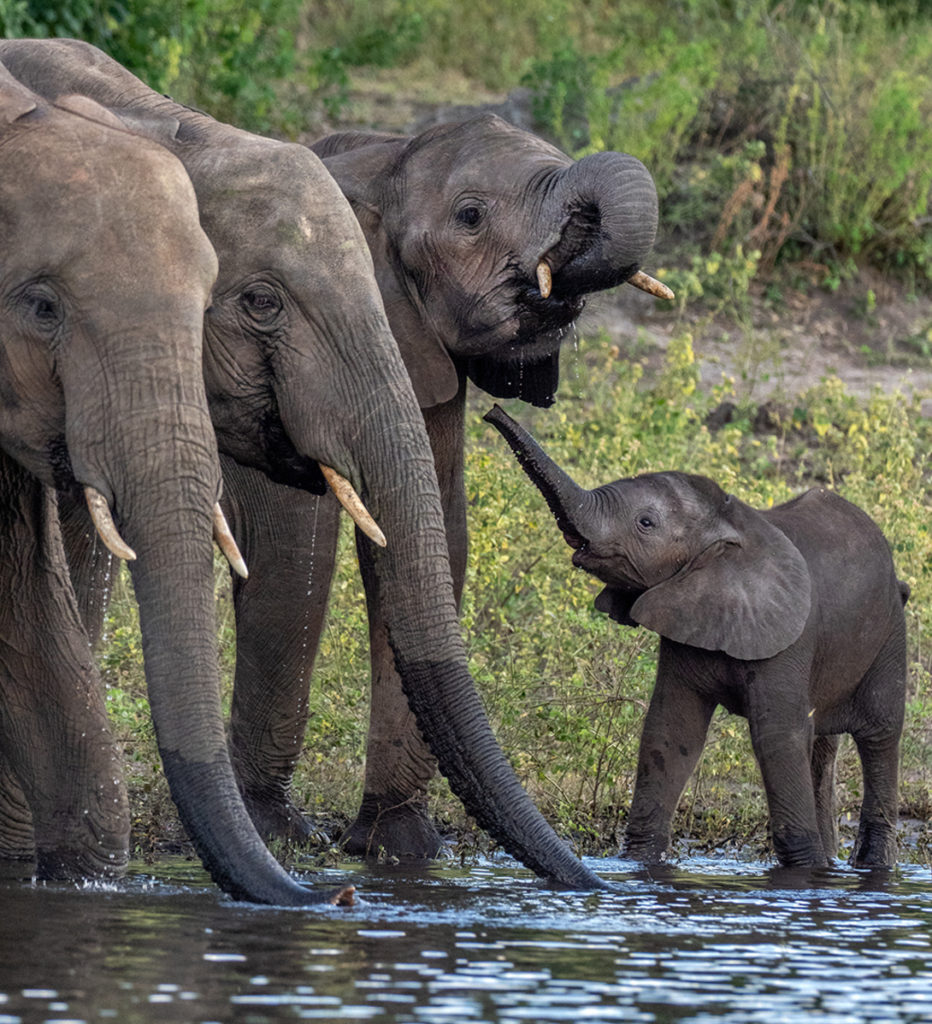
E-M1 MkII M.Zuiko 300mm F4
ITINERARY IN DETAIL:
Day 1 (April 4, 2021): For this tour, you’ll make your reservations to fly into Victoria Falls. We’ll spend the night at the famous Victoria Falls Hotel and begin our adventure by photographing the falls via the hotel’s own path, a 10-minute walk to the falls. Overnight: Victoria Falls Hotel.
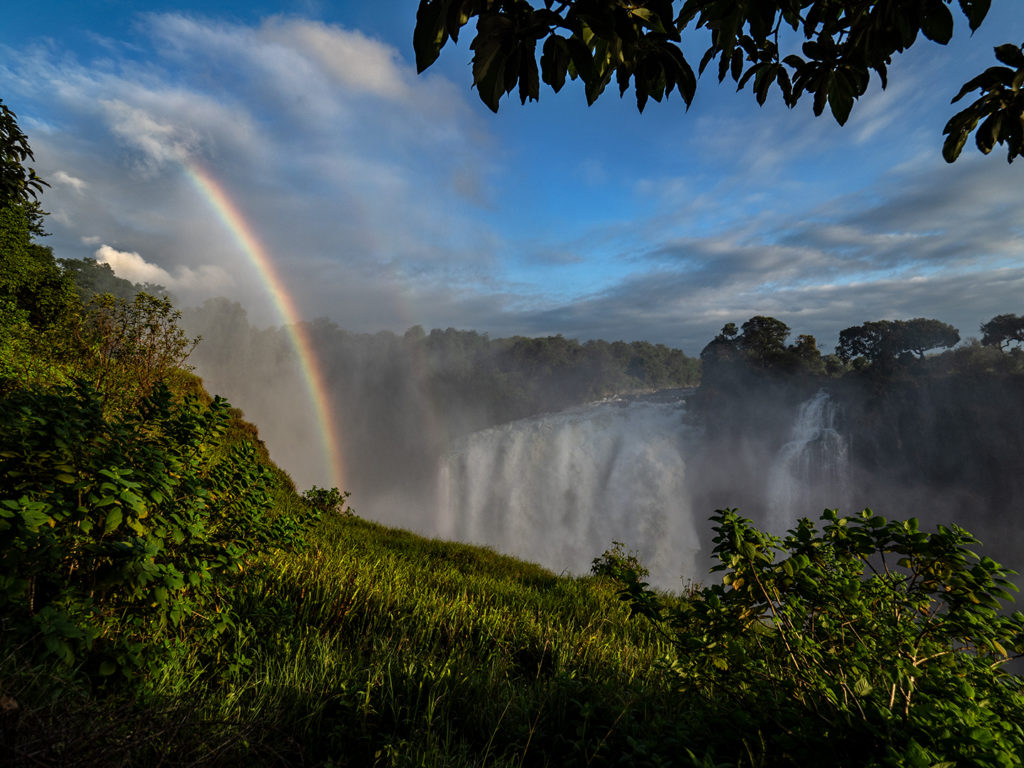
Day 2 (April 5, 2021): Victoria Falls to Chobe and Zambezi Rivers
Today you will transfer you by road to Kasane where you will be met by a representative of Pangolin Photo Safaris and transferred to your houseboat. The Pangolin Voyager Houseboat itself is registered on the Namibian side of the river which is the natural border between Botswana and Namibia. Although you will travel through Botswana to get to the houseboat, please be aware that a few nationalities will require a Namibian visa in advance.
Pangolin Voyager Houseboat: The Pangolin Voyager Houseboat journeys along the Chobe and Zambezi Rivers throughout the year, hosting guests in one of the most game-rich environments in Africa. The Voyager is spread over three levels affording plenty of space for up to 10 guests at any one time. On the lower level the houseboat has5 well-appointed en-suite luxurious cabins. The cabins have built-in cupboards, a cooling fan and the windows are fitted with mosquito net to allow the gentle breeze from the river and the night-time sounds of the Chobe National Park to permeate the rooms. The middle level is occupied by the lounge and dining area along with a deck at the rear which accommodates the Braai (barbeque). The comfortable lounge area is stocked with reference books and binoculars which are yours to use as we drift between our private mooring points. Meals are served on the large dining table and the menu varies depending on what ingredients can be locally sourced throughout the seasons. There is a comprehensive selection of alcoholic and soft drinks for you to enjoy throughout the day from the bar. The upper level hosts a viewing deck equipped with chairs, sun loungers and a table perfect for topping up those tans in between activities and for witnessing the majestic African sunsets that grace us every evening. Trailing behind the Pangolin Voyager is one 8-seater photo boat for those wanting to do a spot of wildlife photography while in this game rich area. Overnight: Pangolin Voyager Houseboat
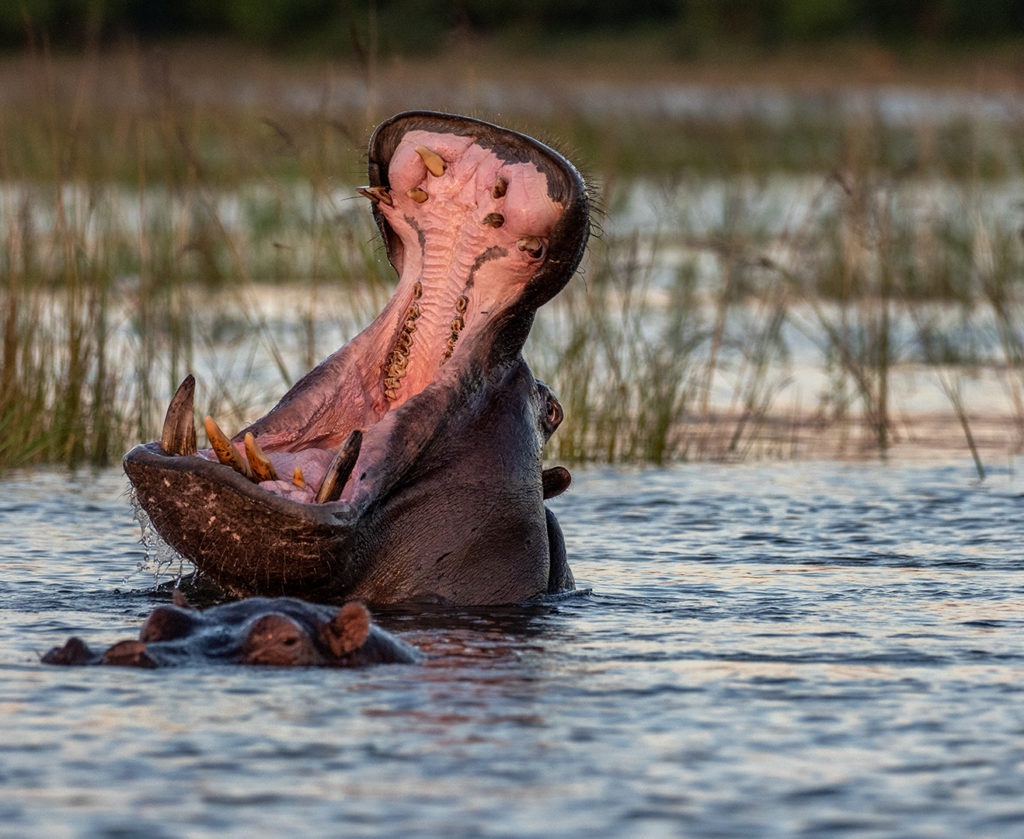
E-M1 MkII M.Zuiko 300mm f4 Pro
Day 3 & 4 (April 6 & 7, 2021): Chobe and Zambezi Rivers
During the day there are a multitude of activities on offer. You will also have access to one 8-seater custom-built photo boat with fully rotating chairs and fitted with state of the art camera mounts moored alongside. Generally, you will be taken out on this boat at first light and again in the late afternoon for up to three hours each time. The Chobe River offers excellent photographic and game viewing opportunities throughout the year from the famous Chobe elephants to smaller inhabitants like tiny Malachite Kingfishers that flit along the banks. Alternatively, there is no better place to relax and unwind with a good book than the sun deck on the upper level of the houseboat. All of the guides on the Voyager are highly trained with an encyclopedic knowledge of the river and its inhabitants and are only too happy to help seek out specific photographic subjects for our guests.
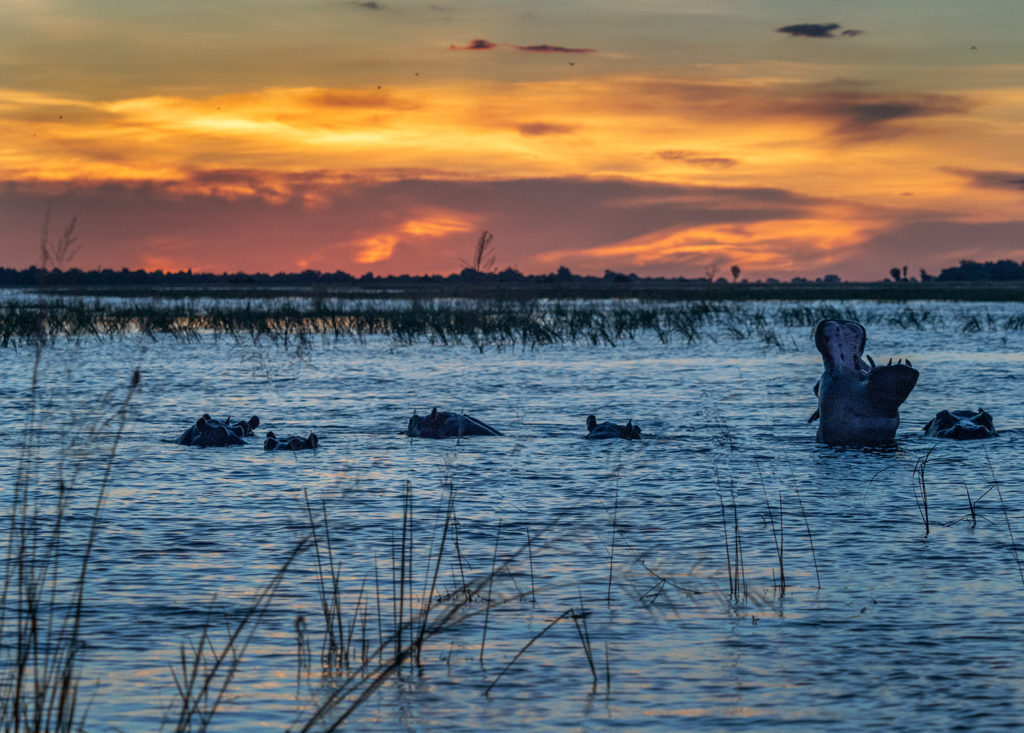
As arguably one of the top game viewing destinations in Africa, the Caprivi floodplain ecosystem offers you a rich and varied game viewing experience from the river. Apart from the huge elephant herds which the Chobe is renowned for, you will be rewarded with sights of large concentrations of buffalo and sable, and predators regularly make an appearance on the Chobe riverfront.
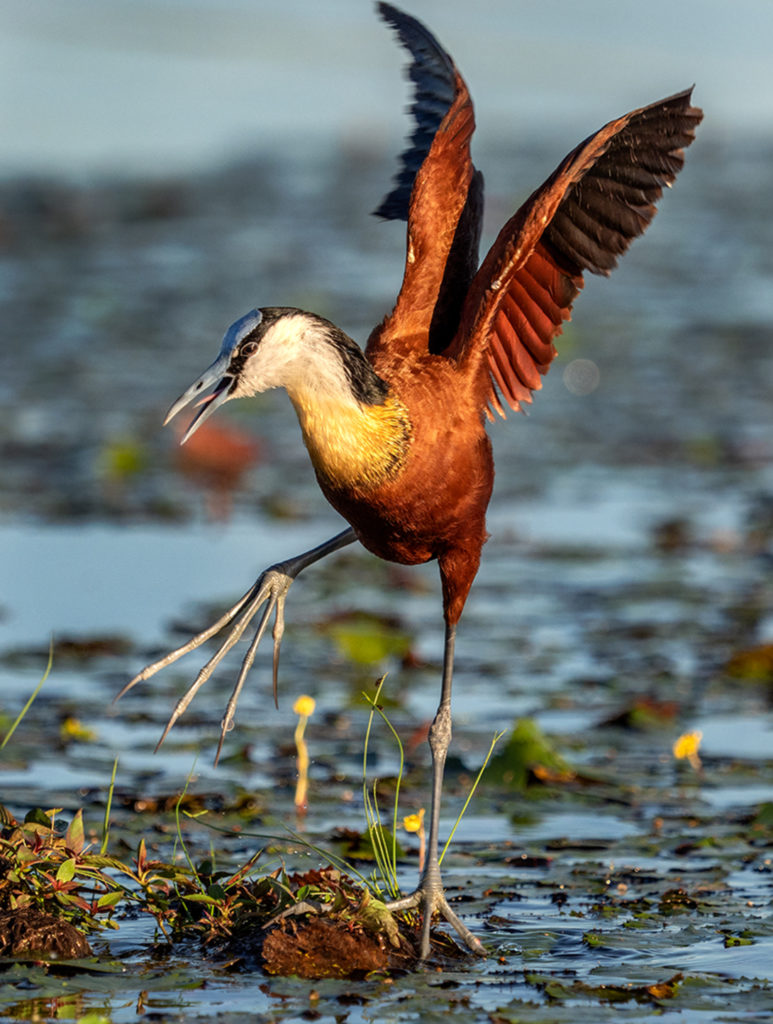
E-M1 MkII M.Zuiko 300mm f4 Pro
Chobe National Park: The Chobe National Park was established in 1967 and is the second largest national park in Botswana, covering 10,566km². Situated in the north-eastern corner of Botswana, the Park takes its name from the Chobe River which acts as its northern boundary. The Park boasts one of the greatest concentrations of game found on the African continent with a vast array of large and small species and over 450 bird species. A major feature of Chobe National Park is its elephant population(particularly when they congregate here in the dry season when water elsewhere is scarce). The Chobe elephant comprise part of what is probably the largest surviving continuous elephant population. This population covers most of northern Botswana as well as northwestern Zimbabwe. Botswana’s elephant population is currently estimated at around 120,000. The Park is sanctuary to four distinctly different eco systems ranging from the riverine areas of the Linyanti and Chobe Rivers, to the mixed deciduous and mopane forests of Nogatsaa, lush plains and dense riverine forest of Serondela and the open grasslands and rocky outcrops of Savuti. Overnight: Pangolin Voyager Houseboat
Day 5 (April 8, 2021): Chobe to Bushmanland
While enjoying your final morning activity you gradually make your way back to the jetty from where you will be transferred on to the Kasane Airport. Here you will be met by your pilots as well as your personal Ultimate Safaris guide before boarding your private light aircraft flight to Namibia. Crossing over into Namibian airspace, your flight first takes you to the bustling town of Katima Mulilo where you will need to complete passport and customs formalities before flying into the Tsumkwe region, previously known as Bushmanland. On arrival you will be met and transferred to Nhoma Safari Camp. I’ve photographed here before and it is visually-rich. No scheduled program, as we’ll spend a lot of time in the Bushman community. This is a real place, not a tourist stop. When I was there I was witness to a “healing ceremony” in late afternoon light and accompanied two hunters as they searched for bush food.
We may see their traditional ceremonies such as the Porcupine or Dama game and possibly in the evenings the powerful Giraffe or Elephant healing dances, the way the healers cure illness and through which social tensions are relieved.
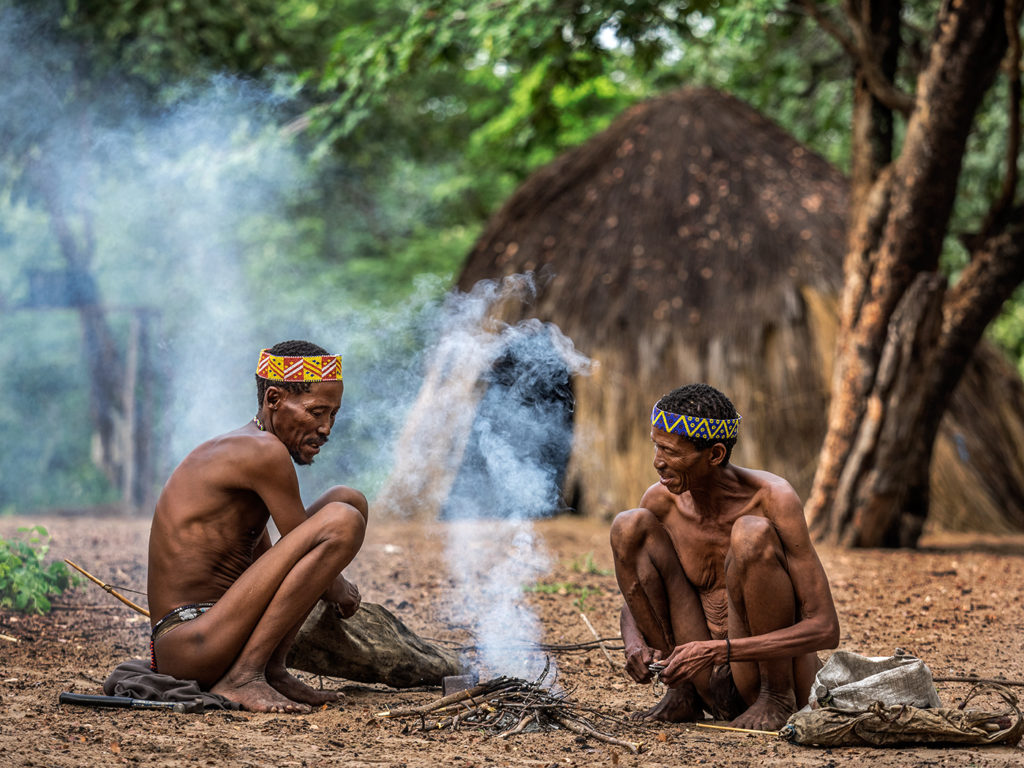
E-M1 MkII M.Zuiko 40-150mm f2.8 Pro Lens
If the Bushmen community are at the nearby //Nhoq’ma Village carrying out their giraffe or elephant healing dances this evening, you may wish to join them for the opportunity to experience this traditional method of curing the sick members of the community. The healing dances are not necessarily a daily occurrence; however, if you are lucky, it might take place at some time during your two night stay at Nhoma Safari Camp.
Nhoma Safari Camp:
Nhoma Safari Camp is a semi-luxury tented camp situated in the north-east of Namibia within the communal land of the Ju/’hoan Bushmen or San, 80km north-west of Tsumkwe. The camp is spread over a vegetated dune with views over the Nhoma omuramba (fossil river bed) and is a short walk from the Ju/’hoan village by the name of //Nhoq’ma. Guests are accommodated in spacious meru style walk-in tents with private verandahs. The safari tents, shaded by large Zambezi teak trees, provide the basic luxuries such as comfortable beds and en-suite bathroom with hot water. At the highest point of the dune is the thatched dining area where wholesome meals are served buffet style. The camp is owned and was built by Arno Oosthuysen with the help of the //Nhoq’ma community with whom he has had an exclusive working agreement since 1999. Tourism allows the community to earn cash in order to buy food and supplies not provided by the surrounding environment. Without tourism, the community may have left their ancestral land and moved to settled areas such as Tsumkwe. Overnight: Nhoma Safari Camp
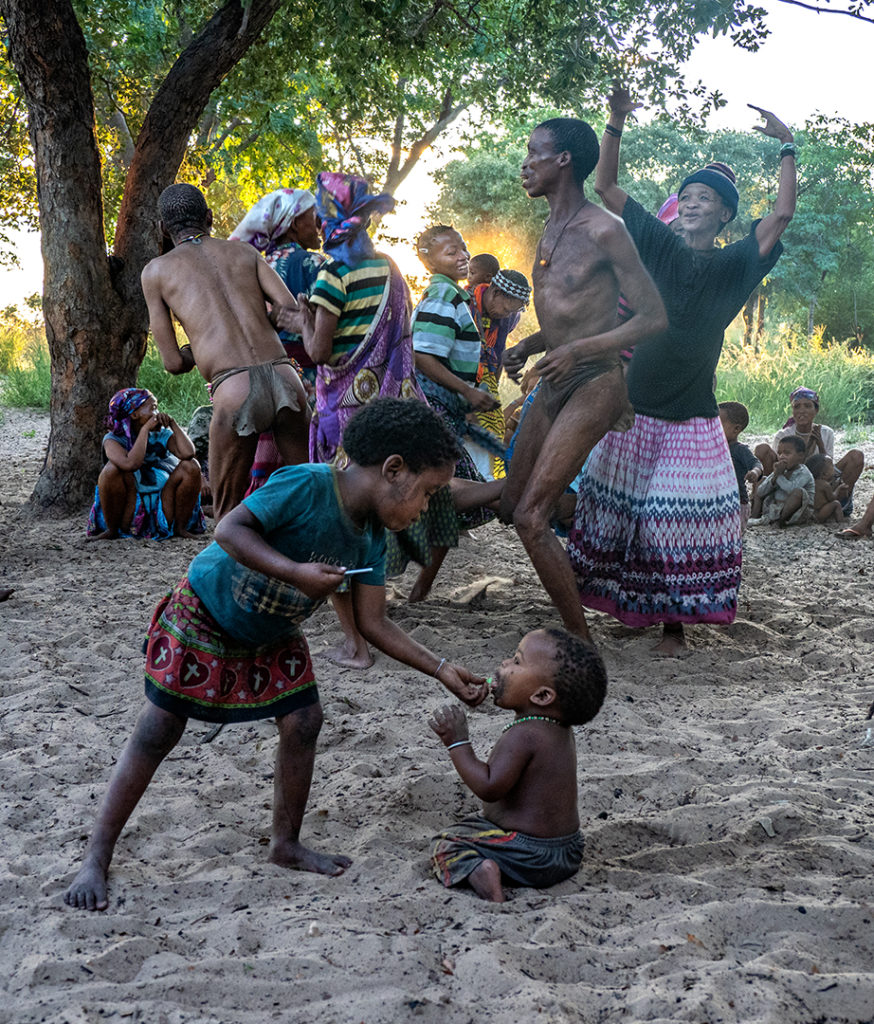
Nhoma Safari Camp is a semi-luxury tented camp situated in the north-east of Namibia within the communal land of the Ju/’hoan Bushmen or San, 80km north-west of Tsumkwe. The camp is spread over a vegetated dune with views over the Nhoma omuramba (fossil river bed) and is a short walk from the Ju/’hoan village by the name of //Nhoq’ma. Guests are accommodated in spacious meru style walk-in tents with private verandahs. The safari tents, shaded by large Zambezi teak trees, provide the basic luxuries such as comfortable beds and en-suite bathroom with hot water. At the highest point of the dune is the thatched dining area where wholesome meals are served buffet style. The camp is owned and was built by Arno Oosthuysen with the help of the //Nhoq’ma community with whom he has had an exclusive working agreement since 1999. Tourism allows the community to earn cash in order to buy food and supplies not provided by the surrounding environment. Without tourism, the community may have left their ancestral land and moved to settled areas such as Tsumkwe. Overnight: Nhoma Safari Camp
Day 6 (April 9, 2021): Tsumkwe Area / Bushmanland

This day is filled with fascinating activities and cultural experiences as arranged by Nhoma Safari Camp in conjunction with the //Nhoq’ma Village. You will be given an in-depth insight into the lifestyle, beliefs, ancient skills and traditions of the Bushmen, one of Namibia’s oldest cultural groups.
There are various activities and experiences that you can enjoy during your time at Nhoma Safari Camp, mostly based around the daily lifestyle and tasks of the //Nhoq’ma community. There is no scheduled activity program, although the usual skills such as fire making, rope making, setting of traps for birds and antelope are guaranteed to be demonstrated, as well as lesser known hunting skills with, for example, the springhare probe. Bush food, water roots and medicines are pointed out or collected, but if honey is found, the hunt will come to a stop until this desirable substance has been collected. Hunters will follow promising spoor of any huntable game, from porcupine to kudu, if they believe that there is a chance to catch up with the animal and the walk could therefore turn into an actual hunt. The duration and intensity of these walks depends entirely on the fitness of the guests and is adaptable. The community participates in traditional games in the afternoon with names such as the porcupine or dama game. This is followed in the evening by the powerful Giraffe or Elephant healing dances, which is the way the healers cure illness and through which social tensions are relieved.
The stereotype image of the San will be replaced by a realistic view of the San and the problems they are facing, but also with appreciation for their skills and knowledge lost by modern man. This is only possible due to the limited number of visitors facilitating individual attention, the location of the camp close to the village, the remoteness and wildness of the surrounding area, the natural friendliness and spontaneity of the community and the impromptu activities. Overnight: Nhoma Safari Camp +
Day 7 (April 10, 2021): Bushmanland to Damaraland
After breakfast you will be transferred back to the Camp’s Airstrip for your private light aircraft flight west across the country to land at the Palmwag Airstrip in the wonderful and diverse region of Damaraland.Depending on your group size, you will be met by your second Ultimate Safaris guide who will be accompanying you for the next few days. From here your journey continues by road, traversing the remarkable Grootberg Mountain Pass to reach Grootberg Lodge, taking time to view game and absorb the vastness of the scenery along the way. The rest of the afternoon is at leisure, with the option to head out on on an interpretive walk with your guides, enjoying the magnificent views from the top of the plateau.
Grootberg Lodge:
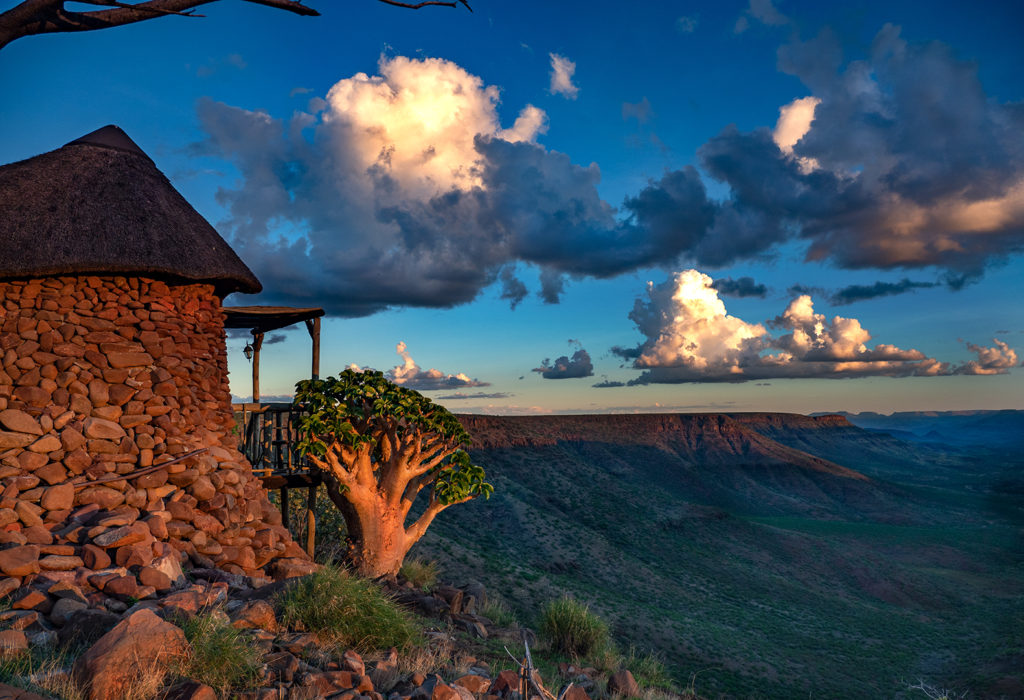
Perched on the rim of the Grootberg Plateau, Grootberg Lodge offers unsurpassed views over the Klip River Valley below. Each of the charming en-suite rock and thatch chalets gaze out over the gorge, where black eagles hunt just below the level of your private deck. The lodge main area with restaurant, bar and swimming pool are also designed to maximize the stunning views. Grootberg Lodgeis a landmark in Namibia for the tourism industry as it is the first middle-market establishment in the country that is 100% owned by the conservancy. 12 000 hectares have been set aside by the local #Khoadi //Hoas community for conservation and tourism. The European Union funded the project through the Ministry of Environment and Tourism’s Development Program with a donation of N$4.5 million to develop the 12 room lodge. The private sector was also called in to supply the training and management skills until the community becomes self-sustainable. This pristine wilderness can be explored either on foot or by vehicle to encounter the inhabitants of this remote biosphere. Desert adapted elephant, black rhino, giraffe, kudu, Oryx and lion are just some of the animals that roam this area. Overnight: Grootberg Lodge
Day 8 (April 11. 2021): Damaraland / Sesfontein area
Today your guides will take you north to reach the small town of Sesfontein where you will get to visit an authentic Himba settlement to learn about the customs and traditions of this ancient people. The Himba are one of the last most traditional peoples of Namibia and have little time for conventional practices. You will learn about the customs and traditions of this very proud nation, and will be given insight into their beliefs, way of life and everyday routine. After visiting the Himba and enjoying a delectable picnic lunch at a scenic location, you make your way back to Grootberg Lodge. After your arrival you will have some time at leisure, which can be spent appreciating the unique surroundings and magnificent views from the top of the plateau.
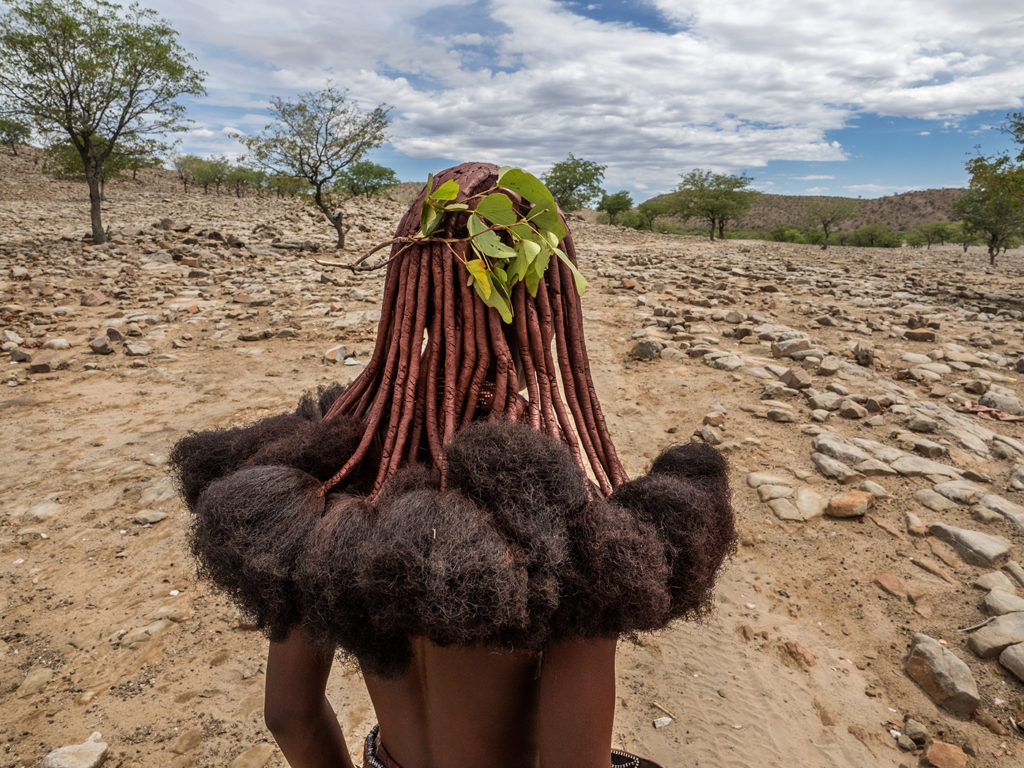
E-M1 MkII M.Zuiko 12-40mm f2.8 Pro lens
The Himba:
The Himba, Tjimba and other Herero people who inhabit Namibia’s remote north-western Kunene Region are loosely referred to as the Kaokovelders. Basically Herero in terms of origin, language and culture, they are semi-nomadic pastoralists who tend to tend from one watering place to another. They seldom leave their home areas and maintain, even in their own, on which other cultures have made little impression. For many centuries they have lived a relatively isolated existence and were not involved to any noteworthy extent in the long struggle for pasturelands between the Nama and the Herero. The largest group of Kaokovelders is the Himba, semi-nomads who live in scattered settlements throughout the Kunene Region. They are a tall, slender and statuesque people, characterized especially by their proud yet friendly bearing. The women especially are noted for their unusual sculptural beauty, enhanced by intricate hairstyles and traditional adornments. They rub their bodies with red ochre and fat, a treatment that protects their skins against the harsh desert climate. The homes of the Himba of Kaokoland are simple, cone-shaped structures of saplings, bound together with palm leaves and plastered with mud and dung. The men build the structures, while the women mix the clay and do the plastering. A fire burns in the headman’s hut day and night, to keep away insects and provide light and heating. A family may move from one home to another several times a year to seek grazing for their goats and cattle. A Himba woman spends as much as three hours a day on her toilette. First she bathes, then she anoints herself with her own individually prepared mixture which not only protects her skin from the harsh desert sun, but also keeps insects away and prevents her body hair from falling out. She uses another mixture of butter fat, fresh herbs and black coals to rub on her hair, and ‘steams’ her clothes regularly over the permanent fire. Men, women and children adorn themselves with necklaces, bracelets, anklets and belts made from iron and shell beads. With their unusual and striking designs, these items have gained a commercial value and are being produced on a small scale for the urban market. Sculptural headrests in particular are sought-after items. Overnight: Grootberg Lodge
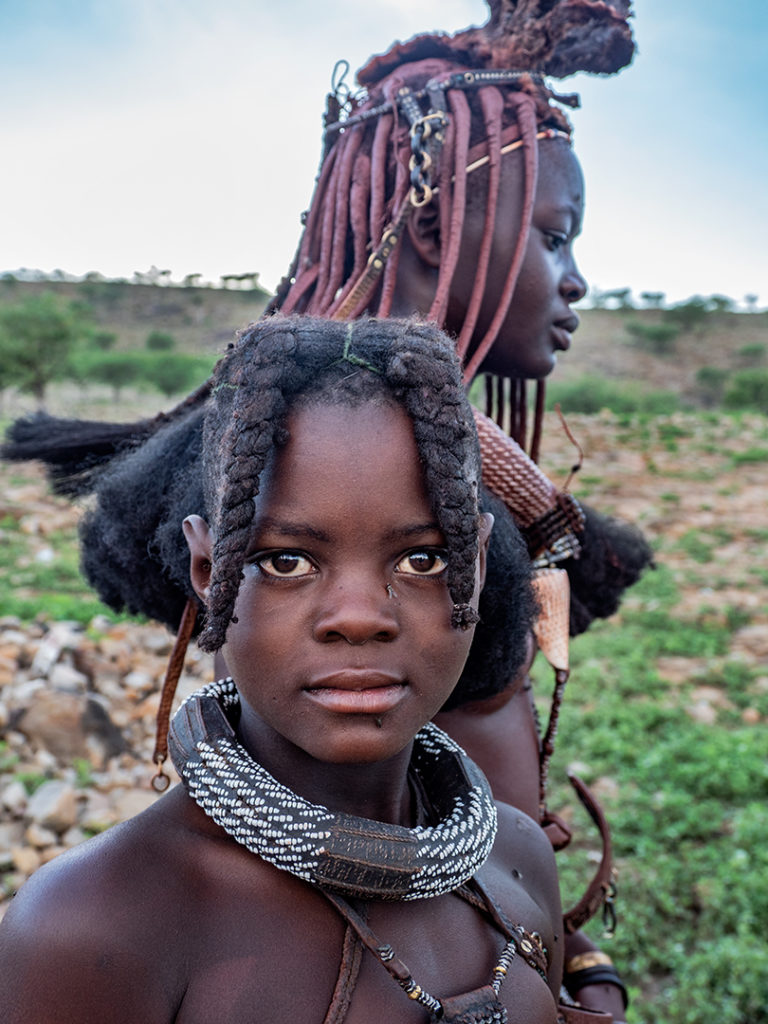
Day 9 (April 12, 2021):Grootberg Mountain to Palmwag Concession
After breakfast you set off on your journey through Damaraland and into the rugged and largely untouched Palmwag Concession to reach the secluded Desert Rhino Camp, enjoying a picnic lunch at a scenic location along the way. The drive from the concession gate to the campacts as a nature drive to give you a taste of this exceptional area and the many different (and some endemic) species of flora and fauna that can be found here – arrival will be in the late afternoon. Damaraland is typified by displays of colour, magnificent table topped mountains, rock formations and bizarre-looking vegetation. The present day landscape has been formed by the erosion of wind, water and geological forces which have formed rolling hills, dunes, gravel plains and ancient river terraces. It is the variety and loneliness of the area as well as the scenic splendour which will reward and astound you, giving one an authentic understanding of the word ‘wilderness’.
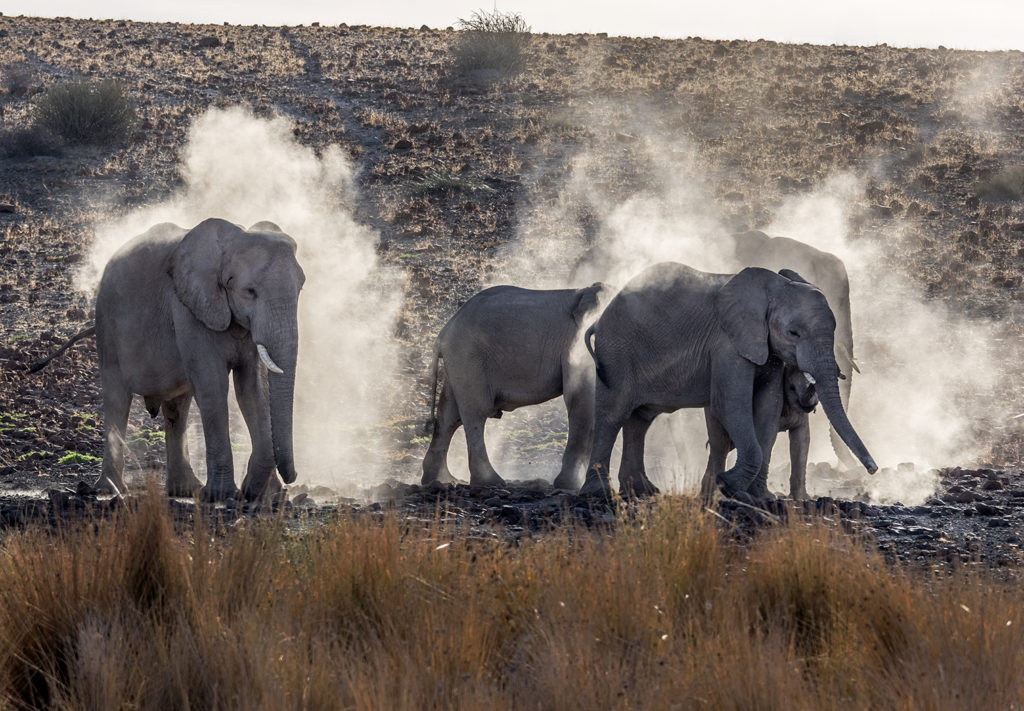
E-M1 MkII M.Zuiko 40-150mm f2.8 Pro lens
Desert Rhino Camp:
Desert Rhino Camp is a comfortable and charming tented camp located on the unique Palmwag concession in rugged northern Damaraland. This camp offers a fascinating insight into the ecology and conservation of the area, as well the incredible desert adapted black rhino. Desert Rhino Camp lies amongst rolling, rocky hills with scattered euphorbia, ancient Welwitschia plants, scrubby vegetation and isolated clumps of trees of the 450,000ha Palmwag Concession. This region is marked for its tranquil, minimalist beauty, surprising wealth of arid-adapted wildlife and the largest free roaming black rhino population in Africa. Set in a wide valley sometimes flush with grass, accommodation at Desert Rhino Camp is in Meru-style canvas tents, raised from the ground on a wooden deck. Each tent features an en-suite bathroom with a hand basin, flush toilet and shower. Beds are made up with crisp, white linen and have two dark wood bedside tables with wicker reading lamps. An extension of the deck functions as a front verandah where guests can relax in director’s chairs to take in the magnificent vistas of the surrounding desert and Etendeka Mountains. The tented restaurant and lounge area of Desert Rhino Camp is also raised on a wooden deck in a single tent which is open plan and has partially open sides offering panoramic views. To one side there are couches and to the other a large, simple dining table. Evening meals are taken around the fire pit, in front of the lapa, where guests can relax and socialize. Activities during your stay here include guided 4×4 scenic drives, rhino tracking, walks, birding and nature drives. Desert Rhino Camp functions as a collaborative effort between Wilderness Safaris and the Save the Rhino Trust (SRT) – an NGO that has been has been instrumental in the preservation of these rare, desert adapted black rhino. Having barely survived the slaughter of ’80s and ’90s throughout other parts of Africa, the black rhino population has doubled since the formation of the SRT. Overnight: Desert Rhino Camp
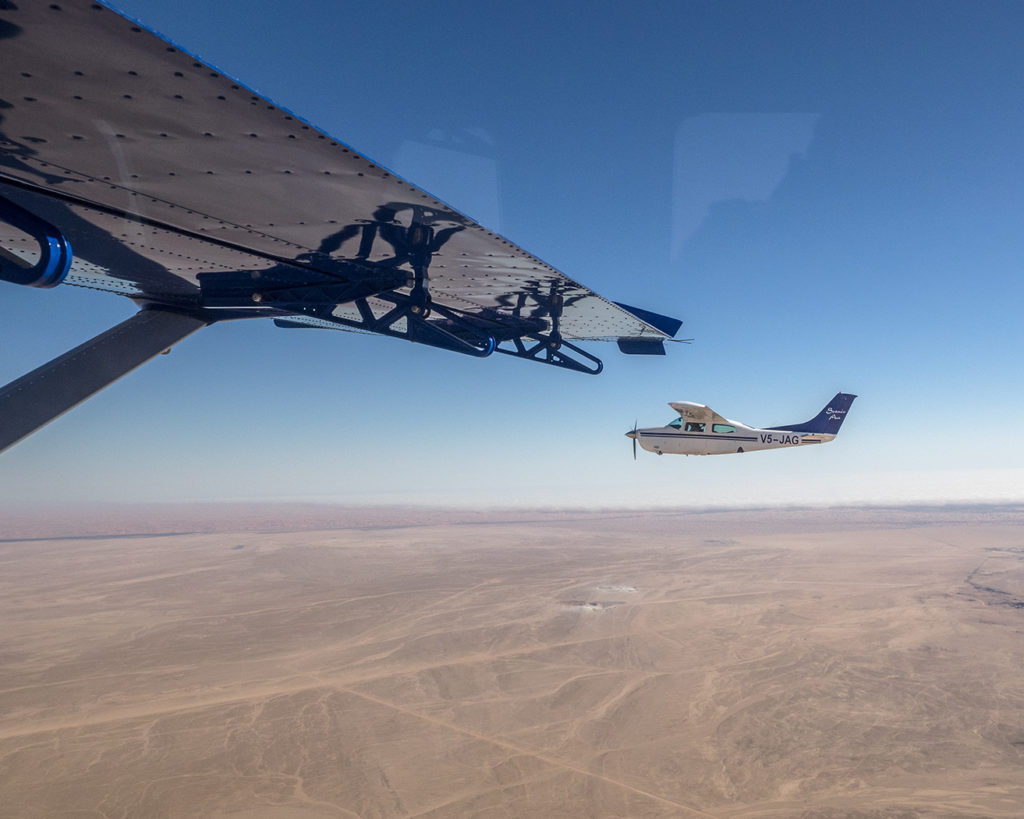
Day 10 (April 13, 2021): Desert Rhino Camp, Palmwag Concession
A full day of guided excursions within the expansive Palmwag Concession as arranged by Desert Rhino Camp. You will get to spend an exciting and memorable morning out rhino tracking with the assistance of staff and trackers from “Save the Rhino Trust” (SRT), followed by a picnic lunch before returning to camp in the early afternoon. Afterwards, you can relax at camp until you head out again later in the afternoon for a scenic nature drive or walk. Wildlife in the area includes Hartmann’s mountain zebra, giraffe, desert adapted elephant, ostrich, lion, oryx, spotted and brown hyena, cheetah, kudu, leopard, and in particular this area is home to one of the world’s largest natural populations of the rare black rhino.
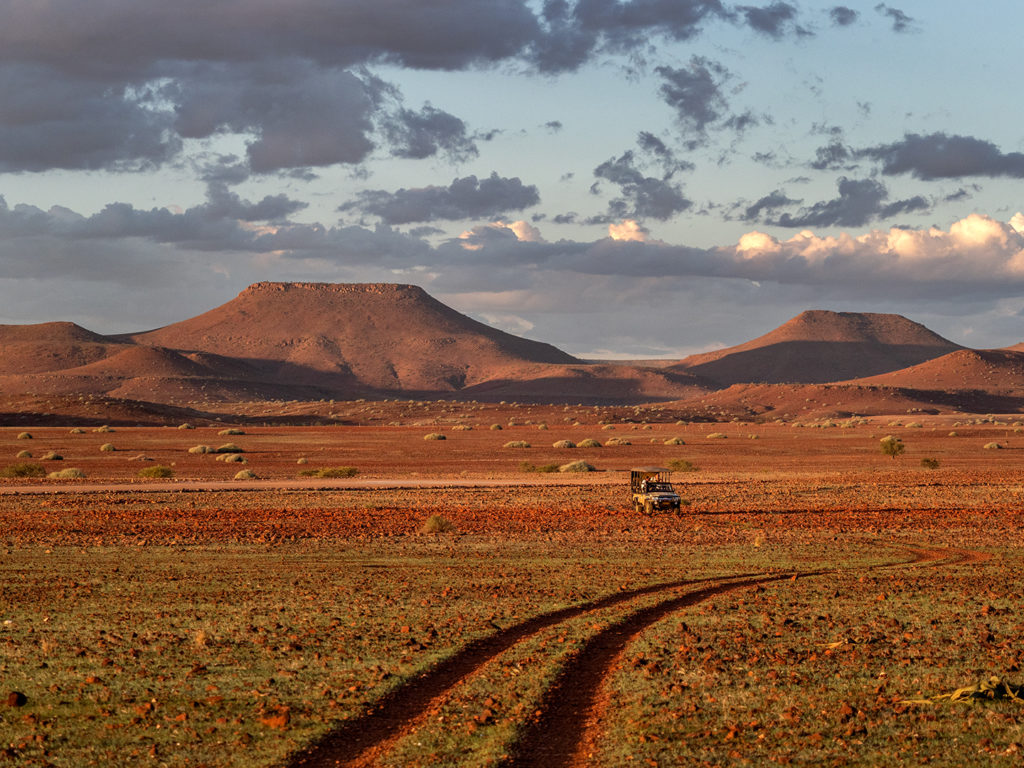
Palmwag Concession:
The Palmwag Concession spans 4,500km² of arid wilderness transected by Ephemeral River courses which, along with the occasional natural spring, provide an oasis to the wildlife that have adapted to this harsh environment. The rugged mountains and canyons provide a last refuge for some of the continent’s most unique wildlife such as the legendary desert elephant, lion and the last free-roaming black rhino population on earth. In fact seventy-five per cent of Namibia’s endemic species inhabit this last bastion of the wilderness.
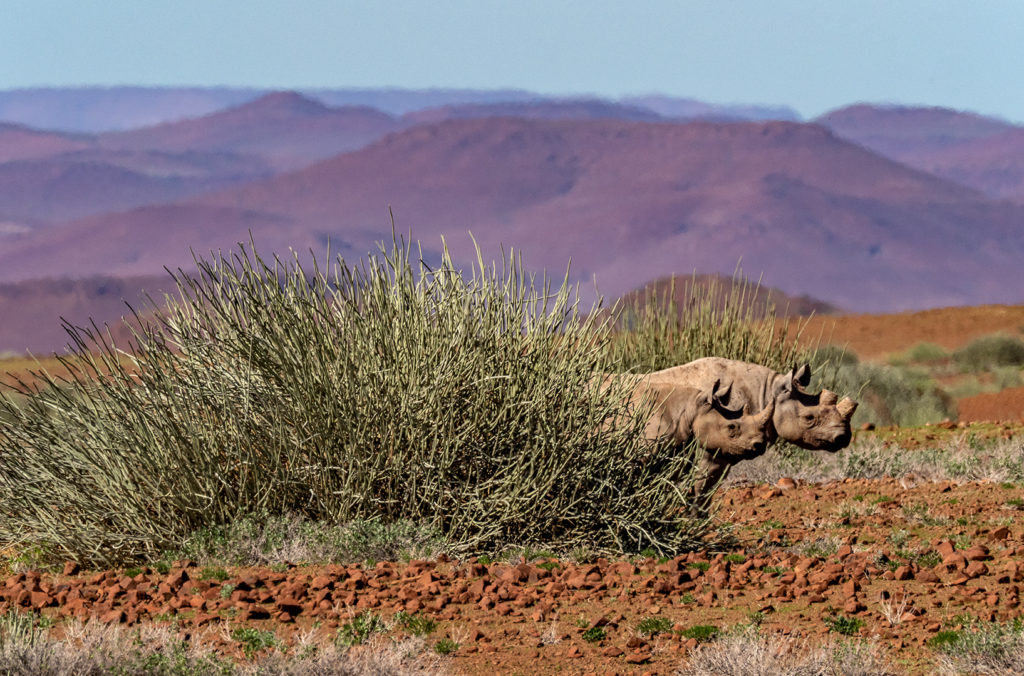
Desert Black Rhinoceros:
Namibia is home to the larger of two subspecies of the black rhinoceros found in southern Africa. The only population that remains in the wild, unfenced and outside reserves occupies an arid range in the western Kaokoveld. Their preferred habitat is the mountainous escarpment, but they follow ephemeral rivers into the northern Namib as well, especially when conditions are favorable after rains. They are the only black rhinoceros in Africa that are internationally recognized as a “desert group”. Like desert-adapted elephant, they cover great distances. They walk and feed at night and rest during the day. To meet their nutritional and bulk requirements they browse on no fewer than 74 of the 103 plant species that grow in their range. One of the few animals to eat fibrous Welwitschia leaves; they even feed heavily on the milkbush (Euphorbia virosa) with its sharp spines and toxic latex, presumably because of the high water and fat content. They are physical defenses of dryland plants without apparent harm. Once widespread in the subcontinent, black rhinoceros are an endangered species. The smaller subspecies, Diceros bicornis minor, does not range into Namibia. Overnight: Desert Rhino Camp
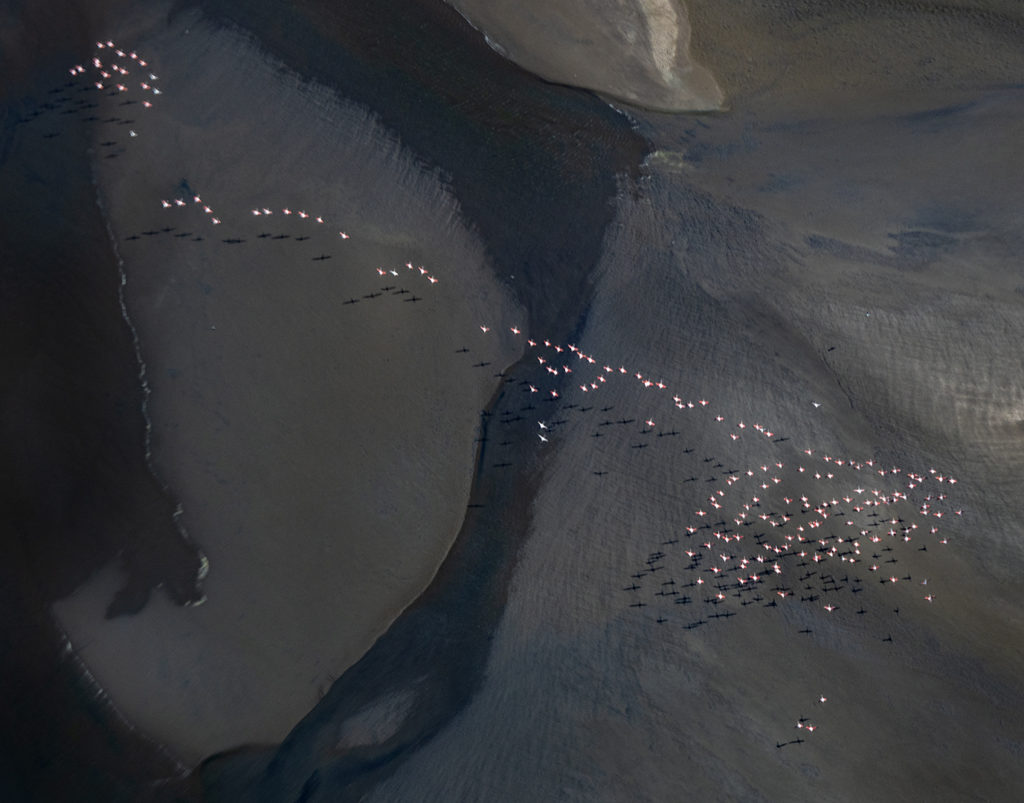
E-M1 MkII M.Zuiko 12-100mm f4 Pro lens
Day 11 (April 14, 2021):Palmwag Concession to Namib Naukluft National Park
After an early breakfast you will be transferred to the lodge airstrip for your private light aircraft flight into the Namib Desert, accompanied by one of your guides. Your flight first takes you southwest to Swakopmund where you will be transferred to a scenic location along the beach for a delectable crayfish lunch next to the Atlantic Ocean. After lunch you will be transferred back to the airport to commence your flight further south into the Namib Desert. Your flight takes you south along the coastline (fog permitting) over Walvis Bay lagoon, the salt pans, Sandwich Harbour and shipwrecks, before heading inland over abandoned diamond mining camps and Sossusvlei, with an amazing bird’s eye view of the great dune sea that stretches inland from the coast, landing at the Sossusvlei Lodge Airstrip.
Here you will be reunited with your second Ultimate Safaris guide who will transfer you into the Namib Naukluft National Park to reach Sossus Dune Lodge. Here you will stay for three nights whilst you explore the remarkable sights of the Namib Desert with your guides. Sossus Dune Lodge is the only lodge that affords you prime location within the boundaries of the Namib Naukluft National Park.If there is still time today, your guides will take you to visit Sesriem Canyon, a nearby geological attraction, or explore Elim Dune. However, if you prefer, you can just relax and soak in the scenic and tranquil surroundings at Sossus Dune Lodge.
Sesriem Canyon:
Sesriem Canyon has evolved through centuries of erosion by the Tsauchab River which has incised a narrow gorge about 1.5km long and 30m deep into the surrounding conglomerates, exposing the varying layers of sedimentation deposited over millions of years. The shaded cool depths of the canyon allow pools of water to gather during the rainy season and remain for much of the year round. These pools were a vital source of water for early settlers who drew water for their livestock by knotting six (SES) lengths of rawhide thongs (riems) together, hence the canyon and surrounding area became known as Sesriem.
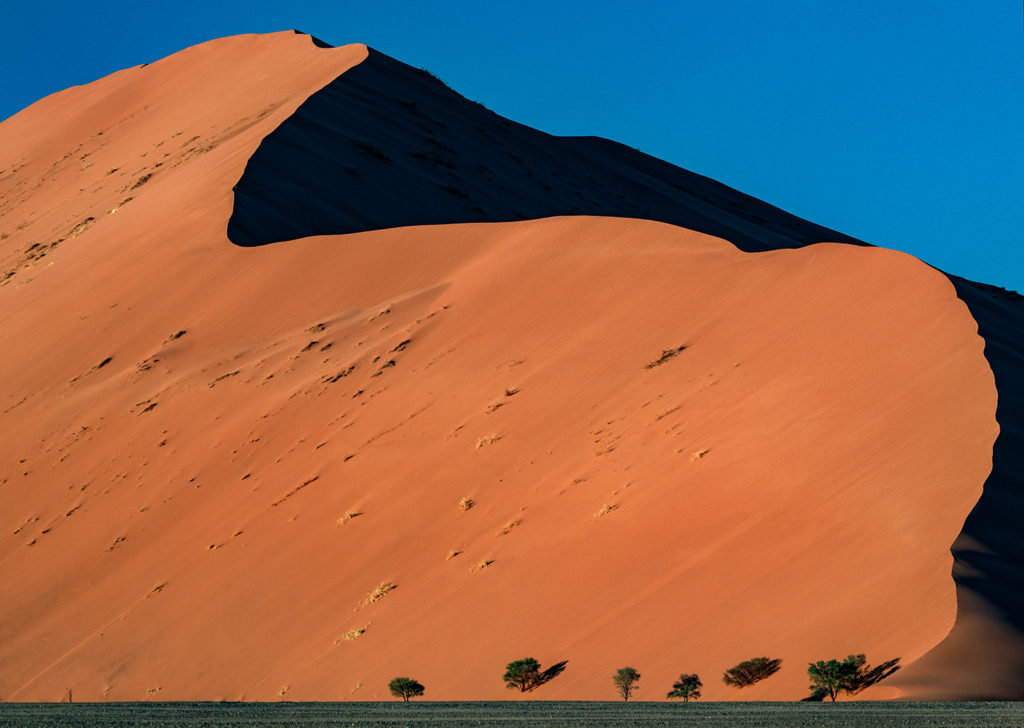
E-M1 MkII M.Zuiko 40-150mm F2.8 Pro lens
Sossus Dune Lodge:
Sossus Dune Lodge is built in an environmentally sensitive manner, primarily from wood, canvas and thatch, in an attractive ‘afro–village’ style. Situated within the Namib Naukluft Park, close to the Sesriem Canyon, and providing sweeping vistas of the dunes to the west, guests benefit from being able to reach Sossusvlei before sunrise, or to stay until after sunset. Accommodation units are interlinked by elevated wooden walkways, and consist of 23 well-spaced en-suite desert chalets, equipped with tea stations and small fridges, with an additional relaxation gazebo. All units offer magnificent open vistas of the surrounding landscapes. Sossus Dune Lodge offers a good base from which to go on guided excursions to Sossusvlei, Sesriem and the surrounding areas, as well as sunset drives and guided walks, to fully unleash the beauty and biological diversity of the desert environment. Overnight: Sossus Dune Lodge
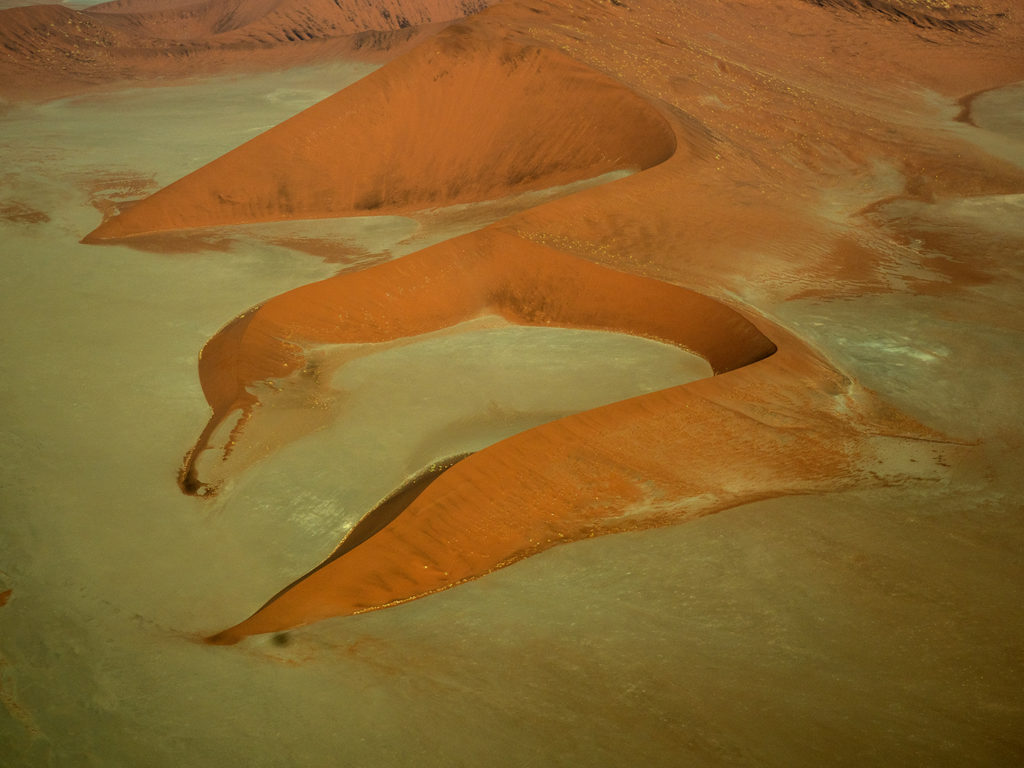
Day 12 & 13 (April 15 &16, 2021): Sossusvlei / Namib Desert
The next two days will be full of photographic opportunities as you rise early for magical excursions into the dunes with your guides. As you are already inside the park you can get into Sossusvlei before everyone else and you would even be able to get there in time to see the sun rise to capture the dunes whilst the light is soft and shadows accentuate their towering shapes and curves. This area boasts some of the highest free-standing sand dunes in the world. Your guides will give you an insight on the formation of the Namib Desert and its myriad of fascinating creatures and plants that have adapted to survive these harsh environs.
Once you have explored the dune fields to your heart’s content you can enjoy a relaxed picnic brunch in the shade of a camel thorn tree. You then return to Sossus Dune Lodge in the early afternoon for lunch, stopping off to view Sesriem Canyon along the way. The rest of the afternoon is at leisure (from experience, this is usually welcomed after an exhilarating morning in the dunes), with the option to head into the dune fields again later in the afternoon to see the dunes whilst the shadows sharpen as the sun goes down.
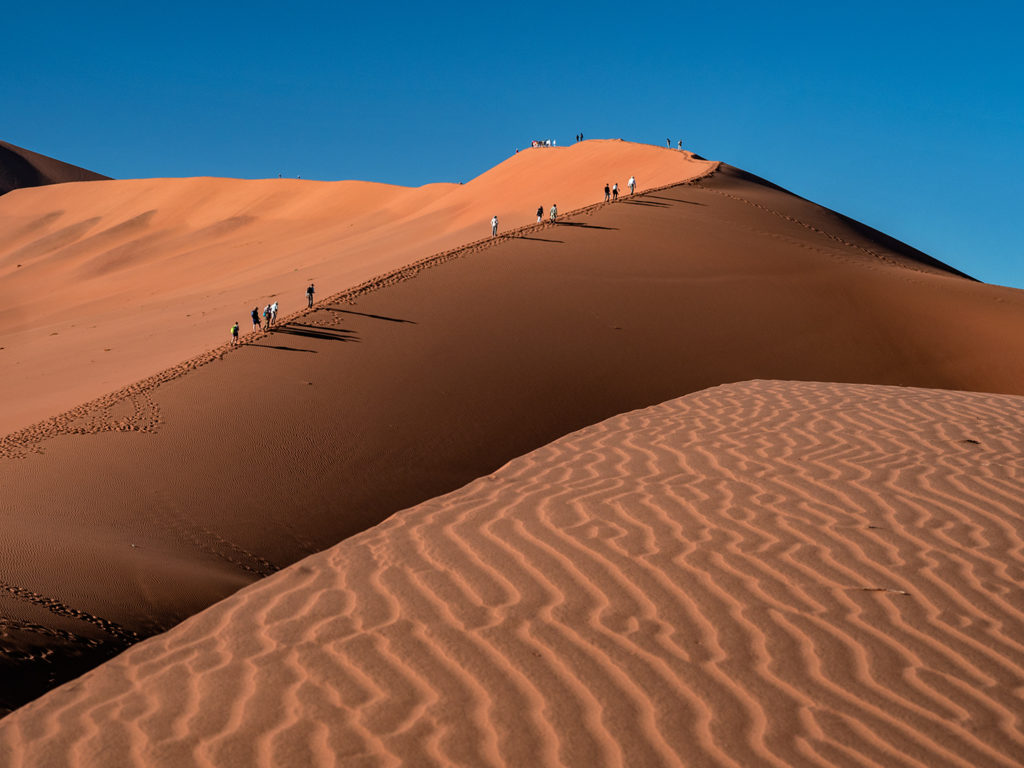
E-M1 MkII M.Zuiko 12-100mm F4 Pro lens
Sossusvlei:
This most frequently visited section of the massive 50,000km² Namib Naukluft National Park has become known as Sossusvlei, famous for its towering apricot coloured sand dunes which can be penetrated by following the Tsauchab River valley. Sossusvlei itself is actually a clay pan set amidst these star shaped dunes which stand up to 300 meters above the surrounding plains, ranking them among the tallest dunes on earth. The deathly white clay pan contrasts against the orange sands and forms the endpoint of the ephemeral Tsauchab River, within the interior of the Great Sand Sea. The river course rises south of the Naukluft Mountains in the Great Escarpment. It penetrates the sand sea for some 55km before it finally peters out at Sossusvlei, about the same distance from the Atlantic Ocean. Until the encroaching dunes blocked its course around 60,000 years ago, the Tsauchab River once reached the sea; as ephemeral rivers still do in the northern half of the Namib. Sand-locked pans to the west show where the river previously flowed to before dunes shifted its endpoint to where it currently gathers at Sossusvlei. Roughly once a decade rainfall over the catchment area is sufficient to bring the river down in flood and fill the pan. On such occasions the mirror images of dunes and camel thorn trees around the pan are reflected in the water. Sossusvlei is the biggest of four pans in the vicinity. Another, famous for its gnarled and ghostly camel thorn trees, is Deadvlei which can be reached on foot over 1km of sand. Deadvlei’s striking camel thorn trees, dead for want of water, still stand erect as they once grew. They survived until about 900 years ago when the sand sea finally blocked the river from occasionally flooding the pan. Overnight: Sossus Dune Lodge
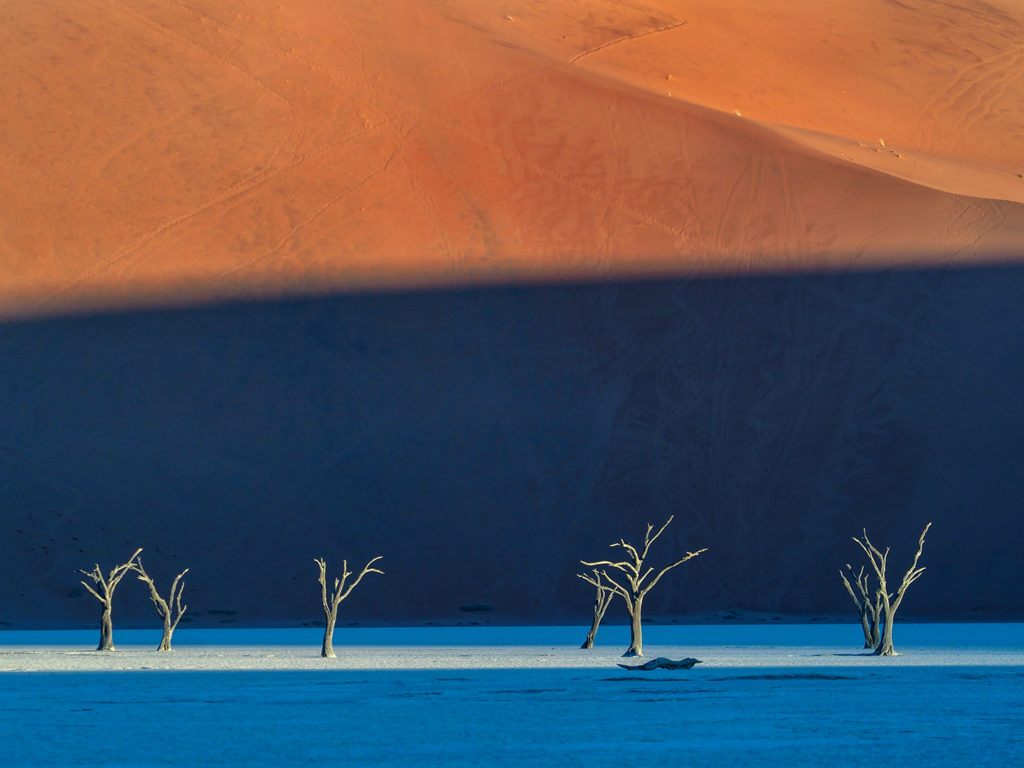
Day 14 (April 17, 2021): Sossusvlei Area to Lüderitz
Today’s journey takes you further south through a section of the NamibRand Nature Reserve and the spectacular scenery of the Tiras Mountain Conservancy to reach the wind-swept coastal town of Lüderitz, keeping a lookout for the legendary feral desert horses along the way. This afternoon your guides will arrange for you to visit the ghost town of Kolmanskop. Stepping back in time, you will have the opportunity to explore the desolate streets and abandoned buildings and photograph this fascinating site before returning to Lüderitz (non-commercial photo permit included).
Feral Horses:
An intriguing feature of the Sperrgebiet is the legendary desert horses seen from the road when traveling between Lüderitz and Aus. There are several theories regarding their origin. Some considered that they were descended from farm animals that had escaped, or were horses of the stud belonging to Baron von Wolf, who built Duwiseb Castle north east of Garub and another theory is that they are descended from the German Schutztruppe who abandoned Aus during the South West African Campaign in 1915. New recent research carried out by Telané Greyling in 2005 suggests that the herd was drawn from all of the above as well as the South African army. About 100km east of Lüderitz, a signpost indicates the turn-off to Garub, a maintained water point where the wild horses can be observed and photographed as they come back to drink.
Lüderitz Bucht: The town of Lüderitz stands in isolation on a great frontier between the desert and ocean. Beyond the structures huddled together beside the bay and a lighthouse on the peninsula, the surroundings are much as Bartolomeu Dias found them in 1487, when his flotilla of three small ships first sailed into the uncharted anchorage. The town lands form an enclave in the ‘Sperrgebiet’, 26,000km of coastal desert rich in diamonds. The greater part of the Sperrgebiet lies to the south. Northward the dune fields of the great Sand Sea sprawl overland to the horizon and far beyond. Lüderitz was built on a windswept, rocky hillside and ridge beside the bay. Behind the town, out of sight from the sea, a black-topped road runs into the interior. Outside the town limits it passes Kolmanskop, now a ghost town, where diamonds were first mined in the Namib. Lüderitz is located on the only part of the Namibian coast with a rocky shore. A peninsula with numerous coves, locally called fjords and bays, juts out of the coast at an angle to form the bay proper. Three small islands – Penguin, Seal and Flamingo – lie within the bay. Shark Island was once also an island in the bay, but a solid causeway now joins it to the mainland. It encloses the harbour and yacht basin.
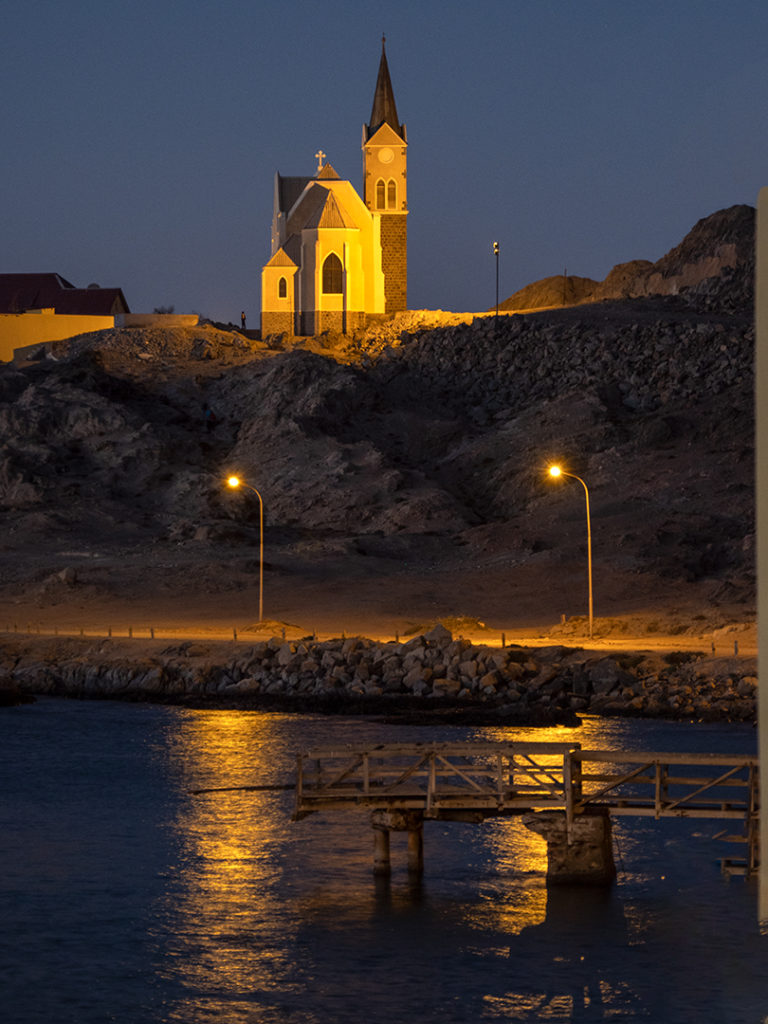
Lüderitz Nest Hotel:
Situated directly on the Bay, Lüderitz Nest Hotel offers sea-facing rooms with en-suite bathrooms, telephone, air-conditioning, television, and tea/coffee facilities. The private beach, sauna, swimming pool and bar with views over the Lüderitz Bay enhance your stay. The restaurant offers an excellent variety of seafood, including the famous Lüderitz oyster and lobster, freshly attained out of the vibrant fishing harbour. Overnight: Lüderitz Nest Hotel
Day 15 (April 18, 2021): Elizabeth Bay / Kolmanskop
Today you will be treated to a fascinating excursion into the Sperrgebiet restricted area to visit the historic sights of Elizabeth Bay and Kolmanskop. The guided tour will give you an insight into the rich history of diamond mining in Namibia and the rise and fall of both Elizabeth Bay and Kolmanskop, as well as an idea of what everyday life in these settlements would have been like. Today the ghost towns’ crumbling ruins bear little resemblance to their former glory. The stately homes, their grandeur now scoured and demolished by the wind, is gradually becoming sand. In 1980 the mining company CDM restored a number of the buildings in Kolmanskop and established a museum for tourist viewing. After your guided excursion there will be time to wander around the desolate streets and abandoned buildings before returning to the Nest Hotel for dinner.

E-M1 MkII M.Zuiko 7-14mm f2.8 Pro lens
Kolmanskop Ghost Town:
Namibia’s most famous ghost town, Kolmanskop, is situated in the Sperrgebiet about 10km inland from Luderitz. It was named after a transport driver named Jani Coleman, who lived in the settlement of Aus at the turn of the century. During a severe sandstorm he was forced to abandon his ox wagon on the small incline from where Kolmanskop can be seen. It stood there for a while; giving rise to the name Colemanshuegel, which eventually became Kolmanskop. In 1908 the railway worker Zacharias Lewala found a sparkling stone amongst the sand he was shovelling away from the railway line near Kolmanskop. August Stauch, his supervisor, was convinced he had found a diamond. When this was confirmed, the news spread like wildfire, sparking a frantic diamond rush and causing fortune hunters to converge in droves on Kolmanskop. It soon became a bustling little centre with a butchery, bakery, furniture factory, soda water and lemonade plant, four-skittle alley, a public playground and even a casino and swimming pool. The town’s development reached its pinnacle in the twenties, with approximately 300 German adults, 40 children and 800 Owambo contract workers living there. In spite of, or probably because of, the isolation and bleakness of the surrounding desert, Kolmanskop developed into a lively little haven of German culture, offering entertainment and creation to suit the requirements of the affluent colonialists for whom large, elegant houses were built. The well-equipped hospital boasted southern Africa’s first X-ray machine. However, when richer diamond deposits were discovered further south, the CDM (now Namdeb) headquarters were moved to Oranjemund in 1943, in 1950 all mining operations ceased and by 1956 the town was totally deserted. Today the ghost town’s crumbling ruins bear little resemblance to its former glory. The stately homes, their grandeur now scoured and demolished by the wind, are gradually becoming sand. In 1980 the mining company CDM restored a number of the buildings and established a museum for tourist viewing.
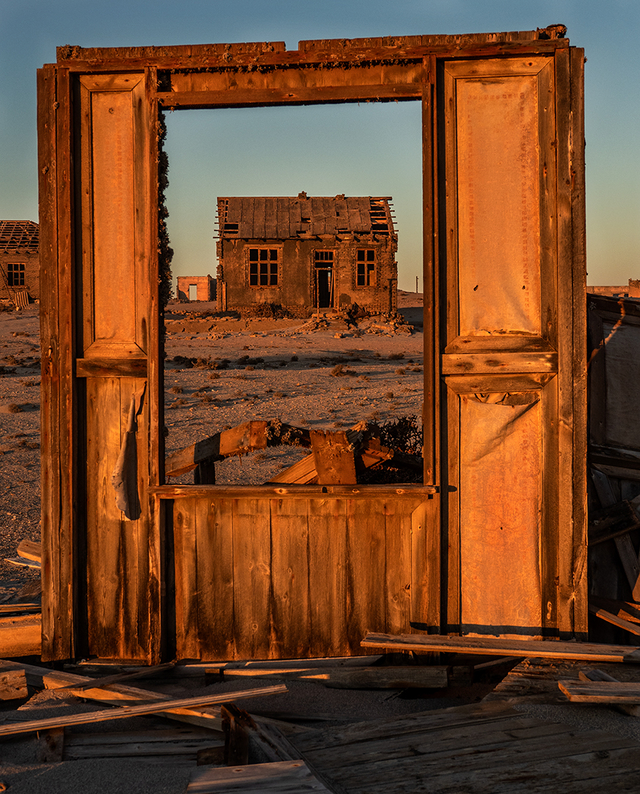
E-M1 MkII M.Zuiko 12-100mm f4 Pro lens
Elizabeth Bay Ghost Town:
Located about 30km south of Lüderitz within the Sperrgebiet National Park, Elizabeth Bay ghost town lies on the coast and has therefore eroded much faster than Kolmanskop ghost town. Battering winds and coastal fog that has crumbled the structures into fascinating skeletons of what they once were. The town was built to house mineworkers and their families. Inhabited from 1926 to 1935, it is now being recaptured by the desert and has become a windswept place of fragile ruins. Diamonds were mined off and on at Elizabeth Bay from 1911 to 1948 with major interruptions due to world wars and economic recessions. The mine was reopened nearby the ghost town in 1991 with modern infrastructure, and can be seen on the drive to Elizabeth Bay ghost town. The workforce for this new mine now lives in Lüderitz. Overnight: Lüderitz Nest Hotel
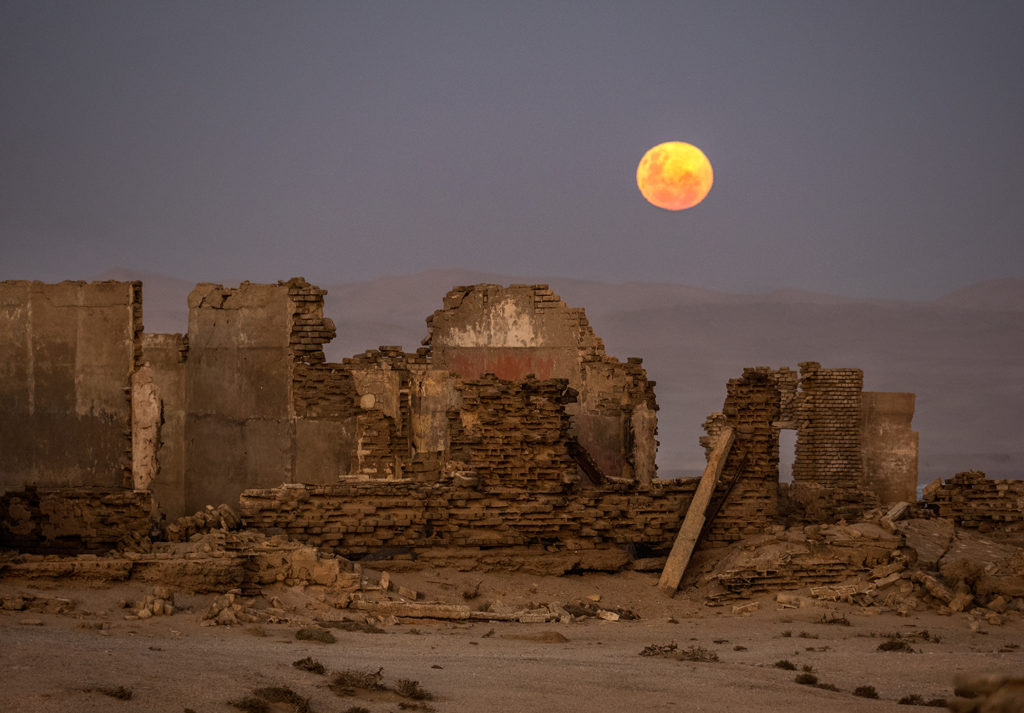
E-M1 MkII M.Zuiko 40-150mm f2.8 Pro lens
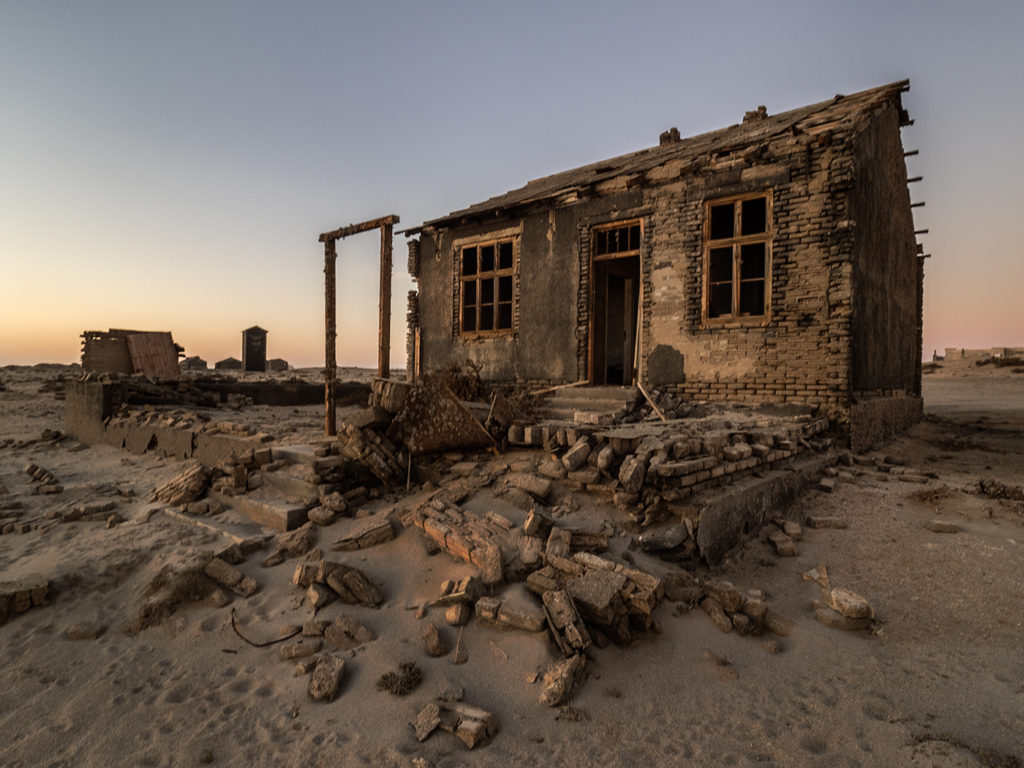
E-M1 MkII M.Zuiko 12-100mm f4 Pro Lens
Day 16 (April 19, 2021): Lüderitz to Windhoek
It’s up early this morning for one last excursion to Kolmanskop. The aim is to reach Kolmanskop early enough to set up your equipment in time to see the sun rise and to capture the dunes and remnants of yesteryear at best light whilst the light is soft and shadows accentuate their eerie shapes and curves. You will then be transferred out to the Lüderitz Airport for your regional flight back to Windhoek, accompanied by one of your guides. On arrival at Windhoek’s local Eros Airport you will be met by an Ultimate Safaris representative who will transfer you to the Hilton Hotel for the final night of your safari. Dinner this evening can either be enjoyed at your hotel, or out at one of the popular restaurants in town with your guide.
Windhoek Capital City:
Windhoek, Namibia’s capital nestles among rolling hills, bounded by the Eros Mountains in the east, the Auas Mountains to the south and the Khomas Hochland in the west. It is a meeting place between Africa and Europe, the modern and the old. In the capital’s main street, well-preserved German colonial buildings are in sharp contrast with modern architectural styles, while Herero women in their traditional Victorian dresses mingle with executives dressed in the latest fashions. Located centrally, Windhoek is the starting point of an adventures holiday for many visitors to the country and an ideal base from where to explore the rest of the country. The city’s restaurants offer a variety of meals, ranging from international and continental cuisine to German dishes such as Eisbein with Sauerkraut and African delicacies such as Mopane worms.
Hilton Hotel:
In the heart of Namibia’s capital city lies the spectacular Hilton Hotel. In an exceptional downtown location, Hilton Windhoek emanates pure opulence with impressive facilities and Hilton’s hallmark hospitality. The Hilton Windhoek Hotel’s lobby lounge and café, Centrum, features large bay windows and warm, neutral decor. With 110 seats split over a stylish lounge area and a tree-shaded, decked terrace, Centrum at the Hilton Windhoek Hotel overlooks the vibrant city of Windhoek. The Hilton offers 150 rooms and suites, and their King Guest rooms will provide guests with both space and comfort. Rooms feature traditional African inspired décor and are furnished with king-sized beds, LCD TV, high-speed internet access and an elegant en-suite bathroom with a range of luxurious amenities and separate rain shower. Overnight: Hilton Hotel
Day 17 (April 20, 2021):Depart from Windhoek International Airport
This morning can be spent relaxing at your hotel, exploring Windhoek, visiting NamCrafts and the Craft Centre, or doing some last minute souvenir shopping if time allows, before you are collected from the Hilton Hotel for your transfer out to the Windhoek International Airport to arrive in time to check in for your ongoing flight.
This is truly a unique opportunity to see the photographic “Crown Jewels” of Namibia in an very efficient, very comfortable way. During our time in Namibia, we’ll spend evenings (and, of course, all day-long, too) discussing photography—or finding answers to the world’s problems. We’ll also be reactive to great photo opps, stopping wherever and whenever to capture those great moments.
PRICING:
You’ve been looking for this paragraph from the start..the price is $22,000.00 per person. Namibia is becoming a very sought-after destination, and we incurred a greater than 10% increase on cost from last year. We’ve also added more days to this year’s trip from 2018.
Single supplements are available for $ 995.00
Please note: Travel insurance/trip cancellation insurance is required by Ultimate Safari’s & FirstLight Workshops.

E-M1 MkII M.Zuiko 40-150mm f2.8 Pro lens
PRICE INCLUDES:
- Accommodation as stated above.
- Transportation in luxury air-conditioned safari vehicles as indicated.
- All meals, starting on April 15, dinner at the Victoria Falls Hotel until the last day in Windhoek, May 1 breakfast.
- Services of registered and experienced English-speaking naturalist safari guides.
- Private light aircraft charter flights as indicated (in 1x Cessna C208 – for passengers, and 1x Cessna C210 for luggage when necessary), fuel and local airport tax included.
- All entrance fees and excursions as described in above itinerary.
- Arrival and departure airport transfers.
- Mineral water on board the safari vehicle and light aircraft flights.
- Local beverages (water, beers, ciders, juices, soft drinks, house wines and local spirits) throughout safari, except whilst at Victoria Falls Hotel where drinks will be for your own account.
- Welcome pack.
PRICE EXCLUDES:
- International flights to Victoria Falls, as well as related airport taxes.
- Any meals not included in the above itinerary (e.g.: dinner at Victoria Falls Hotel).
- Any entrance fees and excursions not included in the above itinerary.
- Premium or vintage wines and champagnes as well as imported spirits.
- Laundry (laundry service available at certain lodges at extra cost).
- Gratuities & porterage.
- Travel insurance (mandatory).
- Items of personal nature (telephone expenses, curios, medicines etc.).
- ENTRY VISA FEES.
If Namibia is on your travel map, and you plan to make one trip there in your life, this is the one. THIS WORKSHOP WILL SELL OUT QUICKLY, WE ARE OFFERING THIS ON A “FIRST-COME, FIRST-SERVED” basis. Please give us a call or respond via email to discuss further.
Hoping to see you in Namibia!
Jay Dickman FirstLight Workshop 303 730 2894 Jaybec@comcast.net
This is the Kodiak or Cessna Caravan aircraft we’ll be using on the internal flights. Additionally, we will use a Cessna 210 for luggage.


